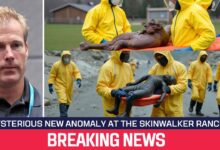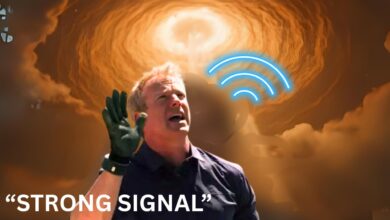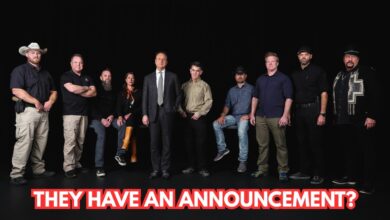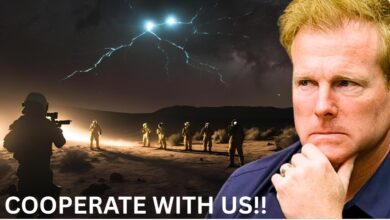Skinwalker Ranch Officials ANNOUNCES a DIRE WARNING!!
Skinwalker Ranch Officials ANNOUNCES a DIRE WARNING!!

The world is oblivious to the ranch and its secret. Most of them have been hidden under the rug and most of them are filtered through the lens.
While the Navajos have their own stories, the Skinwalker Ranch team has been taking a scientific angle which has been confusing to say the least. Maybe they are deities or maybe they are just extraterrestrials on Earth hidden in plain sight. Or maybe a forte dimensional being working in the dark.
Well, this episode has the answers.
Episode 11 of The Secret of Skinwalker Ranch season 6, titled Hard to Handle, may be one of the most groundbreaking and unsettling installments in the show’s history. What begins as a straightforward materials analysis quickly spirals into a jaw-dropping revelation about a strange ceramic-like substance pulled from deep within the mesa. This isn’t just a case of finding something unusual. It’s the kind of discovery that forces the team and the audience to confront the possibility that they’re not dealing with ordinary geology at all, but with the remnants of something built with a level of technology that current science can’t yet explain.
The History Channel’s preview hinted that the team would face a hard decision about their next steps. After watching the events unfold, it’s clear why. The latest lab results don’t merely suggest an unusual compound. They point towards something adaptive, possibly even self-healing, as though the material is alive in a way that isn’t biological, but technological.
The episode opens with the drilling crew, and scientists gathered around the latest spoils from deep cing inside the mesa. As the samples are laid out under bright work lights, it’s immediately obvious that this isn’t normal sediment or rock. The shards glint faintly in the light, dense, glassy, and unnaturally uniform in texture, almost like engineered ceramics used in high-grade aerospace applications. But these samples weren’t dug out of a hanger. They came from hundreds of feet inside a natural mesa in rural Utah.
The drill team’s mood shifts when they examine one of the drill teeth. These teeth are made from tungsten carbide, one of the hardest materials available, capable of grinding through granite with minimal wear. And yet, the tooth is nearly worn smooth. Its cutting edge eaten away as though it had been dragged across a material with hardness beyond anything on the MO scale of minerals. This isn’t just a sign of resistance. It’s as if the bit had been chewing into something that actively pushed back.
When Travis Taylor holds the fragment of the drill tooth next to the ceramic shard, there’s an unspoken recognition in the room: whatever is inside that mesa doesn’t want to be breached easily. The conversation quickly turns to the possibility that they may be dealing with advanced composites, materials engineered to endure extreme temperatures, pressure, and even electromagnetic stress. The implications are staggering. If these ceramics are part of a larger structure or device, they may have been placed here intentionally, perhaps to contain something or to protect it from discovery.
Later, in a more controlled lab setting, spectroscopy and scanning electron microscopy reveal compositions that don’t align neatly with known geological formations. The density and microstructure suggest an origin involving controlled manufacturing at extremely high temperatures far beyond what ancient human civilizations could achieve and not consistent with any known industrial waste or debris.
As Brandon Fugal and the team gathered to discuss the findings, the tension in the room is palpable. This is no longer just a curiosity. This is potentially the smoking gun that hints at buried advanced technology beneath Skinwalker Ranch. And if it’s still functional, as some readings suggest, it could be actively influencing the electromagnetic anomalies, sightings, and unexplained events that have plagued the property for decades.
By the time the episode closes, the Hard to Handle title takes on multiple meanings. The substance itself is almost impossible to penetrate. The implications are difficult to accept, and the decision of whether to push forward is heavier than ever. If they keep drilling, they risk damaging something they don’t understand or awakening something that’s been dormant for centuries.
The scene in the episode shifts like a slow tightening of a noose. First subtle, then impossible to ignore. The mesa drilling site is silent, except for the rhythmic whine of machinery and the faint clink of metal tools being set down on portable tables.
The sun hangs low over the red cliffs, turning the dust in the air a molten orange. Caleb powers down the drill rig, and the crew gathers around as the core sample chamber is carefully unlatched. The smell of scorched rock and lubricant drifts out. Inside the chamber, the extracted segment looks nothing like ordinary sandstone or shale. It’s laced with a pale ceramic-like substance threaded through the rock like veins of quartz, but glossier, almost pearlescent, with an opalescent sheen that shifts in color when moved under the light.
As Eric Bard leans closer, his breath fogs on the cold surface of the material despite it being pulled from hundreds of feet below the mesa where the temperature should be stable. On the workbench under the field microscope, the mystery deepens. Microfissures mar the surface at first glance. But when Taylor lightly brushes the sample with a sterile probe, the fissures close. Not slowly, immediately. It’s as if the material senses disturbance and repairs itself in real time. A faint high-pitched tone begins to rise in the background, just at the edge of hearing.
Most of the team doesn’t notice it until Jim Morse puts a hand to his ear and says, “You guys hear that?” Within minutes, portable EM sensors register fluctuating spikes and a thin line on the oscilloscope dances like a heartbeat. The heartbeat matches the tiny pulses traveling along the microfilament strands embedded in the ceramic. On the monitor, they light up intermittently. Bright, sharp flashes, then nothing, then flashes again, too regular to be random.
Dr. Taylor steps back, shaking his head. If this isn’t alive, it’s imitating life damn well. His voice is tense, not odd. He has seen strange things at the ranch before, but never something this deliberate.
In the mobile lab, the spectrographic analysis begins. As the results spill across the screen, the room falls silent. The alloy contains itrium, scandium, and osmium in impossible ratios along with isotopes that don’t match anything in terrestrial samples, materials that would require manufacturing in microgravity or under conditions Earth’s crust has never produced. Brandon Fugal, arms crossed, looks from the screen to the core sample.
“We have to consider,” he says slowly, “that we’re looking at something not of this world.”
The decision to push further is not unanimous. Thomas Winterton warns that if this structure or entity is part of a larger system, breaching it could cause unpredictable consequences. Taylor nods, but points to the borehole camera feed coming in from the depths. Through the murky distortion, a smooth curved wall reflects the camera light in a sharp glint.
For a brief moment, the shimmering field around it ripples like heat rising off asphalt, but in the wrong temperature range, registering cold rather than hot on the thermal readout. The team stares in silence. No one says it, but the thought hangs heavy. Something down there knows they’re here. And then static. The borehole feed cuts out. The screen goes black. No alarms, no malfunctions on the equipment, just silence. Only that faint ringing tone in the air.
It’s here that Brandon makes the call to end the day’s operations. “We regroup, we analyze, and we decide, but we don’t go in blind.” The episode fades out on the image of the mesa, looming in the late light, like it’s guarding a secret it has no intention of giving up without a fight.
Beneath the shadow of the mesa, the air felt charged, almost as if the ground itself knew what had been disturbed. The borehole, once a clear passage into the depths, was now fused shut, not with debris or collapse, but with a seamless weld, as though the very walls had liquefied and reformed in place. The texture was strange, not the blistered chaos of heat damage, but a smooth, deliberate seal, as if some unseen hand or system had decided the opening must not remain.
From the drilling spoils, fragments emerged that defied classification. At first glance, they seemed like pieces of ceramic or high-strength composite, the kind used in aerospace or advanced engineering. Yet, under magnification, their surfaces betrayed a different story. A labyrinth of microchannels, perfectly symmetrical and patterned like a honeycomb, each pore precisely cut.
Then came the moment that upended everything. Under the electron microscope, the material reacted, not slowly, not subtly, but with alarming immediacy. The tiny holes constricted, microscopic fractures smoothed over. In seconds, the surface became flawless again, as if it remembered what it was meant to be.
There was no resin, no adhesive, no chemical residue, just the pure act of restoration unfolding in real time. The closest parallels in human technology, self-healing polymers, shape memory alloys, suddenly felt crude by comparison. Those required triggers like heat, moisture or electrical current. And even then, their repairs were rough, imprecise.
This was different. This was surgical, precise, alive in some way that suggested intent. That thought lingered like a shadow over the table where the samples rested. Was this purely a technological artifact? Or did it straddle the line into biology? The concept of a hybrid, a substance engineered but capable of biological regeneration, was both thrilling and deeply unsettling.
If this was part of a larger structure within the mesa, it might not simply be an inert wall. It could be a living defense designed to isolate, to conceal, to repel intrusion.
In aerospace think tanks, the idea of self-repairing hulls for spacecraft had been a dream of the future, a way to survive the micrometeoroid storms of space. But here, buried in Utah’s high desert, was a material performing that very feat, possibly for centuries, even millennia, without human intervention.
The implications were staggering. The perfect timing of the borehole sudden weld, coinciding with their drill’s deepest reach, seemed almost too exact to be coincidence. To some, it whispered of intelligence, not human, but aware, reactive.
Under the harsh glare of the work lights, the smooth, almost glassy surface of the material seemed inert at first, but every subtle movement suggested otherwise. As the team brought electromagnetic sensors closer, the readings flickered like a heartbeat, reacting to minute vibrations invisible to the naked eye. This was no longer a random anomaly; the material itself appeared to “respond” to human interaction.
Brandon Fugal and team leader Travis Taylor discussed in silence. The quiet wasn’t due to a lack of words but because every moment carried immense weight. If this was a living or semi-living structure, any action could trigger unpredictable consequences. Yet, without further exploration, the mystery might remain forever hidden. One thing was clear: whatever lay beneath the Mesa did not want to be discovered.
The borehole, now seemingly “sealed” on its own, was the clearest evidence. There were no signs of collapse, impact, or high heat. The walls had repaired themselves perfectly, as if something—or someone—had actively closed the opening. Combined with earlier discoveries—off-world metals, unknown compounds, erratic electromagnetic energy—everything pointed to an entity or technology existing beneath the Mesa with extraordinary self-protective capabilities.
During the final analysis of the day, Taylor emphasized that if this was technology, it surpassed anything humans had ever created; if biological, it was no ordinary organism. A material both alive and engineered, both defensive and self-repairing, could have persisted for thousands of years. Its form and reactions raised a chilling question: could the strange phenomena reported at Skinwalker Ranch for decades—unexplained lights, moving objects, electronic malfunctions—be the result of an active protective system?
As night fell over the Mesa, its massive silhouette looming in the sunset, the team stood in silence, realizing they had opened a door that might never close. The faint pulse from the sensors continued, a subtle but persistent reminder that Skinwalker Ranch was not just land or legend. It was an entity, a technological relic or unknown lifeform, a secret breathing quietly beneath their feet.
The episode ends with the Mesa still and silent, but far from peaceful. The team withdraws, carrying samples and data, burdened with uncertainty: will the next step unlock unprecedented knowledge, or awaken something beyond their control? Beneath the dry red earth, the answer waits, quietly observing.
Yet when damaged, it quietly reformed, sealing itself as if no intrusion had ever occurred. It was more than a strange material. It was a warning. The possibility emerged that this was not a random geological oddity, but a deliberate construct, a protective shell encasing whatever was hidden deep within the mesa. The implications were unsettling. The fact that the bore hole itself sealed after drilling wasn’t merely a bizarre inconvenience. It was a calculated act, as though the mesa were defending itself from further intrusion.
The team’s memories returned to earlier seasons. Malfunctioning instruments, GPS units that spun wildly off course, drilling rigs that failed without explanation when they neared certain depths. Those anomalies now fit into a far darker framework. The Mesa might be more than an inert formation. It could be aware previous digs had unearthed metallic shards that bore an uncanny resemblance to aerospace grade alloys, the kind used by NASA and SpaceX for re-entry shielding. Now, with the addition of this advanced ceramic, seemingly beyond modern manufacturing, the theory gained new weight. Buried in the mesa might be something ancient or non-human, perhaps even a craft hidden beneath layers of engineered protection.
And this protection might not be passive. In earlier episodes of the season, the team had run into invisible walls in midair, unexplained bursts of energy, distorted radar echoes, and even a strange green gelatinous residue. Traces perhaps of violent high-energy events or subterranean fires from an age beyond memory. The self-healing ceramic could be just one layer in a multi-tier defense system woven together from exotic materials designed to withstand time, intrusion, and even environmental cataclysms.
As the episode unfolded, the tension shifted from curiosity to a pressing dilemma. To press forward with aggressive drilling might pierce whatever shield lay in place, but at the cost of destroying it or triggering a defensive countermeasure. To proceed cautiously would mean delaying answers that had already been decades in the making. The choice was about more than just preserving an artifact. It was about survival. History on the ranch had already shown what might happen when the wrong threshold was crossed: unexplained injuries, sudden radiation spikes, and the mysterious destruction of million-dollar equipment. If the mesa truly housed an intelligent defense mechanism, then the consequences of provoking it could be far more dangerous than anyone had faced before.
Speculation took root in the shadows of the lab. Some whispered of ancient visitors leaving behind self-repairing gateways, dimensional bridges protected by adaptive barriers. Others envisioned a centuries-old crash site where the remnants of a craft had been silently repairing itself, slowly reassembling its structure from within, shielded from human interference by layers of engineered stone and metal. The lab results in drilling footage grounded the investigation in tangible evidence. But beneath it all, a deeper unease spread.
The mesa was no longer just a mystery of geology or history. It was beginning to feel like a living machine, waiting perhaps for the day it would awaken. If either scenario proved correct, “hard to handle” was more than just another entry in the Skinwalker Ranch saga; it could mark the first step toward confirming one of the most extraordinary discoveries in human history. Episode 11 delivers something exceptionally rare in the world of paranormal investigation: a tangible physical artifact that doesn’t merely suggest something unusual, but exhibits behavior that modern science cannot yet account for. The moment when the fractured surface sealed itself before the cameras is a turning point, an image seared into the minds of both the investigators and the audience. It’s the kind of phenomenon that forces a fundamental shift in thinking, where speculation gives way to the unnerving possibility of proof. The self-healing ceramic is more than just a curiosity.
It carries with it an unsettling list of questions. Who engineered it? How ancient is its origin? Was it designed as a barrier to safeguard something hidden deep within the mesa or to confine it? And perhaps the most disquieting question of all: does it possess an awareness of the team’s presence? Its properties suggest it may not exist in isolation, but as part of a multi-layered, highly advanced composite, a fusion of exotic materials seamlessly integrated to form a structure unlike anything naturally occurring on Earth. This is not passive debris. It behaves like a system, perhaps even an organism, adapting to damage and neutralizing threats before they can penetrate its shell. Such possibilities reframe the mesa itself as not being an inner geological feature. It could be a constructed entity, a massive concealed installation with an active defense mechanism.
Theories split into two equally unsettling possibilities. One: that it serves as a dimensional or spatial gateway fortified with self-repairing architecture designed to prevent unauthorized access. The other: that it marks the resting place of a crashed craft slowly and methodically restoring itself over centuries. Both scenarios carry profound implications. If it is a functioning gateway, it may lead to realms or civilizations far beyond Earth’s boundaries. If it is a wounded vessel, then somewhere beneath the layers of rock and clay lies technology and perhaps intelligence that has been quietly rebuilding since long before human settlement of the area.
As the season edges toward its conclusion, the team faces a stark choice: push forward with aggressive drilling, risking catastrophic damage or a defensive response, or pause to develop tools and strategies that could allow for a safer interaction. This decision is not just about preserving the artifact. It’s about survival. Past incidents have already left a trail of unexplained injuries, bursts of radiation, and equipment failures. Now, with evidence of a self-repairing, possibly sentient material, the stakes have never been higher. The discovery shifts the trajectory of the investigation.
Whatever lies within the mesa is no longer a matter of rumor or speculation. It is active, resilient, and perhaps far more aware than anyone is prepared to confront. What happens next may either bring Skinwalker Ranch’s deepest secrets into the light or bury them literally and figuratively for all time.
The discovery of the self-healing ceramic changed everything. This wasn’t just another curious find in the long, strange history of Skinwalker Ranch. It was a potential breakthrough. The kind of anomaly that demanded the world take notice. The fractured piece had sealed itself before the investigators’ eyes as though time itself had been rewound on a microscopic scale. Whatever this was, it didn’t merely hint at the extraordinary—it demonstrated it in a way that defied current science.
If the implications were true, then the mesa was no longer just a looming geological feature. It could be something far more complex, something alive in its own way. The self-healing material might not simply be protecting its inner structure from damage. It might be preserving the integrity of something far older, far more powerful, buried within. That raised unsettling possibilities. Was it shielding a dormant machine? Was it keeping a secret contained? Or even more disturbing, was it conscious enough to know the team was watching? Fringe physics theories suggested a darker possibility: that such self-repairing materials were often integral to systems capable of manipulating energy fields.
Cloaking devices, regenerative architecture, in extreme cases, stabilizers for gateways between worlds. This could explain why aerial radar scans and laser mapping had repeatedly shown shimmering distortions and void-like bubbles surrounding the mesa. It was as if the rock itself wasn’t entirely there, hidden behind a shifting veil of energy that adapted to each probing attempt.
If so, then the ceramic wasn’t merely a repair mechanism. It was part of a biomechanical fortress, a living skin of engineered matter designed to absorb stress, heal damage, and sustain whatever forces turned inside. It might even be an anchor point for a space gate, a machine capable of opening corridors across unimaginable distances or between dimensions. The thought was staggering, yet eerily consistent with what had been unfolding across the ranch for years.
Old indigenous traditions spoke of doorways hidden in the mesas, passages that led to other worlds. Those tales had long been dismissed as folklore. But now, with the material in hand, the old warnings felt less like stories and more like a record of encounters with something real, something ancient.
The ranch’s history provided further evidence. Countless experiments had revealed zones of interference, places where radar beams bent away, GPS signals spun into chaos, and unmanned drones smashed into invisible barriers. These disturbances weren’t random. They clustered around the mesa as though the land itself was wrapped in an intelligent defense grid.
Season 6 had only a few episodes left, but the stakes had never been higher. The team faced a decision: press forward into the heart of the mesa and risk waking whatever might be within, or step back and leave its secrets buried for another generation. Either path promised consequences far beyond the boundaries of the ranch.
And if the self-healing ceramic truly was part of an ancient, still-functioning device, then the investigation had already crossed the threshold. The fortress had noticed them. If that’s the case, then what’s happening at Skinwalker Ranch could be far more coordinated than anyone has dared to suggest. Instead of isolated paranormal events, the sightings, electromagnetic disturbances, GPS blackouts, and now the discovery of a self-healing ceramic might all be different expressions of one integrated defense network: a system designed not just to hide something, but to actively protect it from discovery or tampering.
That means every random interference the team has encountered—the sudden equipment failures, the unexplained radiation spikes, the anomalous weather—could actually be part of an automated response protocol.
If this technology is ancient, it survived centuries without maintenance, which suggests it’s either powered by a virtually limitless energy source or it’s drawing from environmental fields the way living organisms draw from the sun or soil. The presence of creatures in the legends—wolves that can’t be killed, humanoid shapes that vanish into thin air—might be the biological arm of this system, or perhaps synthetic life forms engineered to interact with intruders in ways that confuse, frighten, or disorient.
If so, the mesa may not be an inert geological feature at all, but something closer to a sentient fortress, a biomechanical entity with both the intelligence and the tools to keep its secrets intact. And if the team is now physically damaging its surface, watching it repair itself in real time, they might have triggered a shift from passive observation to active defense. Meaning whatever is inside could soon be preparing for direct confrontation.
The appearance of that low-flying plane wasn’t just an odd coincidence. It carried the quiet weight of surveillance. Someone was watching and not from afar. The suggestion that a third party could be actively recording the team’s every move raises a darker possibility.
The mystery of the Mesa might not be entirely alien in origin, but rather a guarded chapter in a long-running human operation. Whether it’s a US government project buried beneath layers of classification, a private contractor exploiting recovered technology, or even a foreign intelligence agency tracking developments, the implication is the same. The ranch is not as forgotten or remote as it seems.
If those forces have known about the Mesa’s secrets for decades or centuries, then the drilling operation might not just be scientific exploration. It could be a direct intrusion into a long-standing, deliberately maintained cover-up.
In this light, the self-healing ceramic takes on a more complex identity. It may not be purely extraterrestrial. Instead, it could be the end product of a hidden Earth-based program born from reverse-engineered non-human technology, a fusion of alien principles and human ingenuity. If the core of the mesa houses a dimensional device, something capable of bending or manipulating spacetime, then the material’s regenerative properties might serve more than just physical repair. It could be a built-in stabilizer, preventing temporal rifts from spiraling out of control.
This might explain why the structure appears untouched by centuries of natural erosion and why attempts to penetrate it seem to trigger anomalous effects. Over the years, witnesses have spoken of missing time, clocks running backwards, or watching events play out in impossible sequences while on the ranch.
If the Mesa’s technology actively influences time, then drilling into it may not just risk physical danger, it could risk altering causality itself, pulling the team into loops, dislocations, or even alternate timelines. In that sense, the low-flying plane might not have been monitoring for security reasons alone. It could have been there to confirm whether the team’s actions were starting to disturb the delicate balance that has kept this technology dormant.
Until now, the implications were staggering. If this technology truly existed, it might not operate solely within the confines of physical space. It could manipulate time itself. The self-healing ceramic, with its flawless regenerative abilities, might serve a dual purpose: mending physical damage while also sealing fractures in the very fabric of reality.
It was as if the Mesa’s hidden mechanisms acted like cosmic surgeons, patching temporal wounds before they could unravel the sequence of events that held this world together. This reframed the mesa into something far beyond an inert formation of stone. It began to take shape in the mind as a vast living gateway, one that adapted to threats, repaired itself when damaged, and responded to incursions with both passive and active defenses.
The invisible force fields hinted at by electromagnetic disturbances might be its first barrier. An unseen perimeter working in unison with the self-healing material. The roaming wolf-like beasts and shadowy figures whispered about in ranch legends could be more than stories. They might be biological sentinels, organic extensions of this guardian system, emerging when the unseen thresholds were approached.
The human presence around the site added yet another layer of unease. A low-flying aircraft observed during the investigation. Its path, too deliberate to be chance, suggested that someone was monitoring every move.
If the secrets of the mesa had been known for decades or even centuries by governments, private entities, or foreign intelligence, then the team’s work was not a bold first step into the unknown, but a trespass into a long-guarded domain.
The possibility that the self-healing ceramic was not entirely alien, but rather the product of human reverse engineering from recovered non-human artifacts, blurred the line between myth and clandestine technology.
If the Mesa’s heart truly housed a dimensional device, then the healing material might not just prevent collapse; it might stabilize reality itself, keeping timelines intact when they threatened a fracture. This could explain why so many witnesses spoke of missing time, distorted sequences of events, or the uncanny sensation of stepping briefly into another era before snapping back.
With each revelation, the mesa seemed less like a destination to be explored and more like an intelligent threshold deciding who could cross. The deeper the team dug, the more the air felt charged with something both ancient and watchful.
And if the balance that held it all together were ever pushed too far, the warning would not come as a voice or a sign, but as the silent, irrev








